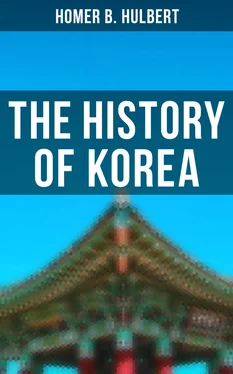Inthe third year of King Ch’ŭm-hă of Sil-la, 249 A.D. the first envoy ever received from Japan arrived at the shore of Sil-la. He was met by Gen. Sŭk U-ro who addressed him in the following unaccountable manner, “It would be well if your king and queen should come and be slaves in the kitchen of the king of Sil-la”. Without a word the envoy turned about and posted back to Japan. An invasion of Korea was determined upon and soon a powerful force landed on the coast of that country. Gen. Sŭk U-ro was filled with dismay and remorse. He confessed to the king that he was the cause of this hostile display and begged to be allowed to go alone and propitiate the advancing enemy. It was granted and he walked straight into the Japanese camp and confessed his crime and asked that he alone be punished. The Japanese took him at his word, burned him alive in their camp and returned to their own land without striking a blow. The following year the same envoy came again and was well received by the king, but the widow of Gen. Sŭk U-ro desiring to avenge the blood of her husband, obtained permission to work in the kitchen of the envoy’s place of entertainment. There she found opportunity to poison his food and thus accomplish her purpose. This of course put an end to all hope of amity between the two countries and that event marks the beginning of the feud which in spite of occasional periods of apparent friendship, existed between the people of Japan and Korea until the year 1868. Hostilities did not however beginat once.
The latter half of the third century beheld few events of special interest in the peninsula. During this period Păk-je seems to have made a spasmodic effort at reform, for we read that she reorganised her official system and set a heavy penalty for bribery, namely imprisonment for life. She also patched up a shallow peace with Sil-la. In Ko-gu-ryŭ a concubine of King Pong-sang tried to incense him against the queen by showing him a leathern bag which she claimed the queen had made to drown her in. The king saw through the trick and to punish the crafty concubine had her killed in the very way she had described. A chief of the Sŭn-bi tribe invaded Ko-gu-ryŭ and desecrated the grave of the king’s father. The wild men of Suk-sin attempted to overthrow Sil-la but the king’s brother drove them back and succeeded in attaching their territory to the crown of Sil-la. It is said that when Sil-la was hard pressed by a band of savages strange warriors suddenly appeared and after putting the savages to flight, as suddenly disappeared. Each of these strange warriors had ears like the leaves of the bamboo and when it was discovered next day that the ground around the king’s father’s grave was covered with bamboo leaves it was believed that he had come forth from his grave with spirit warriors to aid his son.
With the opening of the fourth century the fifteenth king of Sil-la, Ki-rim, made an extensive tour of his realm. He passed northward as far as U-du-ju near the present Ch’un-ch’ŭn. He also visited a little independent “kingdom” called Pi-ryul, now An-byŭn, and made many presents, encouraged agriculture and made himself generally agreeable. Not so with the king of Ko-gu-ryŭ. He was made of sterner stuff. He issued a proclamation that every man woman and child above fifteen years old should lend their aid in building a palace. Ko-gu-ryŭ had of late years passed through troublous times and the people were in no mood to undertake such a work. An influential courtier, Ch’ang Cho-ri, attempted to dissuade the king but as he was not successful he settled the question by assassinating the king. Eul-bul, who succeeded him, had a chequered career before coming to the throne. Being the king’s cousin he had to flee for his life. He first became a common coolie in the house of one Eun-mo in the town of Sil-la. By day he cut wood on the hill sides and by night he made tiles or kept the frogs from croaking while his master slept. Tiring of this he attached himself to a salt merchant but being wrongfully accused he was dragged before the magistrate and beaten almost to death. The official Ch’ang Cho-ri and a few others knew his whereabouts and, hunting him up, they brought him to the “Pul-yu water” a hundred and ten li from P’yŭng-yang, and hid him in the house of one O Măk-nam. When all was ripe for the final move, Ch’ang Cho-ri inaugurated a great hunting party. Those who were willing to aid in dethroning the king were to wear a bunch of grass in the hat as a sign. The king was seized and imprisoned, and there hanged himself. His sons also killed themselves and Eul-bul was then elevated to the perilous pinnacle of royalty.
It was about the beginning of this century also that the Japanese, during one of those spasmodic periods of seeming friendship asked the king of Sil-la to send a noble maiden of Sil-la to be their queen. The king complied and sent the daughter of one of his highest officials, A-son-geup-ri.
Rise of Yŭn … rebellion against China … siege of Keuk Fortress raised. … Ko-gu-ryŭ surrenders to Yŭn. … Ko-gu-ryŭ disarmed. … Japanese attack Sil-la. … Păk-je’s victory over Ko-gu-ryŭ … moves her capital across the Han. … Păk-je people in Sil-la. … Yŭn is punished. … Buddhism introduced into Ko-gu-ryŭ … and into Păk-je … amnesty between Ko-gu-ryŭ and Păk-je … but Ko-gu-ryŭ continues the war. … Păk-je in danger … envoy to Japan. … Ch’ŭm-nye usurps the throne of Păk-je … and is killed. … Sil-la princes rescued. … Ko-gu-ryŭ and Păk-je receive investiture from China. … China’s policy. … Nul-ji’s reign. … Ko-gu-ryŭ and Păk-je transfer their allegience. … Yŭn extinct … beginning of triangular war … diplomatic relations. … Ko-gu-ryŭ falls from grace … first war vessel … diplomatic complications. … Păk-je humiliated … her capital moved.
We have now come to the events which marked the rise of the great Yŭn power in Liao-tung. They are so intimately connected with the history of Ko-gu-ryŭ that we must give them in detail. For many years there had been a Yŭn tribe in the north but up to the year 320 it had not come into prominence. It was a dependency of the Tsin dynasty of China. Its chiefs were known by the general name Mo Yong. In 320 Mo Yong-we was the acting chief of the tribe. He conceived the ambitious design of overcoming China and founding a new dynasty. The Emperor immediately despatched an army under Gen. Ch’oe-bi to put down the incipient rebellion. Ko-gu-ryŭ and the U-mun and Tan tribes were called upon to render assistance against the rebels. All complied and soon the recalcitrant chieftain found himself besieged in Keuk Fortress and was on the point of surrendering at discretion when an event occurred which, fortunately for him, broke up the combination and raised the siege. It was customary before surrendering to send a present of food to the one who receives the overtures of surrender. Mo Yong-we, in pursuance of this custom, sent out the present, but for some reason it found its way only into the camp of the U-mun forces while the others received none. When this became known the forces of Ko-gu-ryŭ, believing that Mo Yong-we had won over the U-mun people to his side, retired in disgust and the Chinese forces, fearing perhaps a hostile combination, likewise withdrew. The U-mun chiefs resented this suspicion of treachery and vowed they would take Mo Yong-we single-handed. But this they could not do, for the latter poured out upon them with all his force and scattered them right and left. From this point dates the rise of Yŭn. Gen. Ch’oe-bi fearing the wrath of the Emperor fled to Ko-gu-ryŭ where he found asylum. Here the affair rested for a time. The kingdom of Yŭn forebore to attack Ko-gu-ryŭ and she in turn was busy strengthening her own position in view of future contingencies. Ten years passed during which no events of importance transpired. In 331 Eul-bul the king of Ko-gu-ryŭ died and his son Soé began his reign by adopting an active policy of defense. He heightened the walls of P’yŭng-yang and built a strong fortress in the north, called Sin-sŭng. He followed this up by strengthening his friendly relations with the court of China. These facts did not escape the notice of the rising Yŭn power. Mo Yong-whang, who had succeeded Mo Yong-we, hurled an expedition against the new Sin-sŭng Fortress and wrested it from Ko-gu-ryŭ. The king was compelled, much against his will, to go to Liao-tung and swear fealty to the Yŭn power. Two years laterthe capital was moved northward to Wan-do, in the vicinity of the Eui-ju of today. This was done probably at the command of Yŭn who desired to have the capital of Ko-gu-ryŭ within easy reach in case any complications might arise.
Читать дальше









